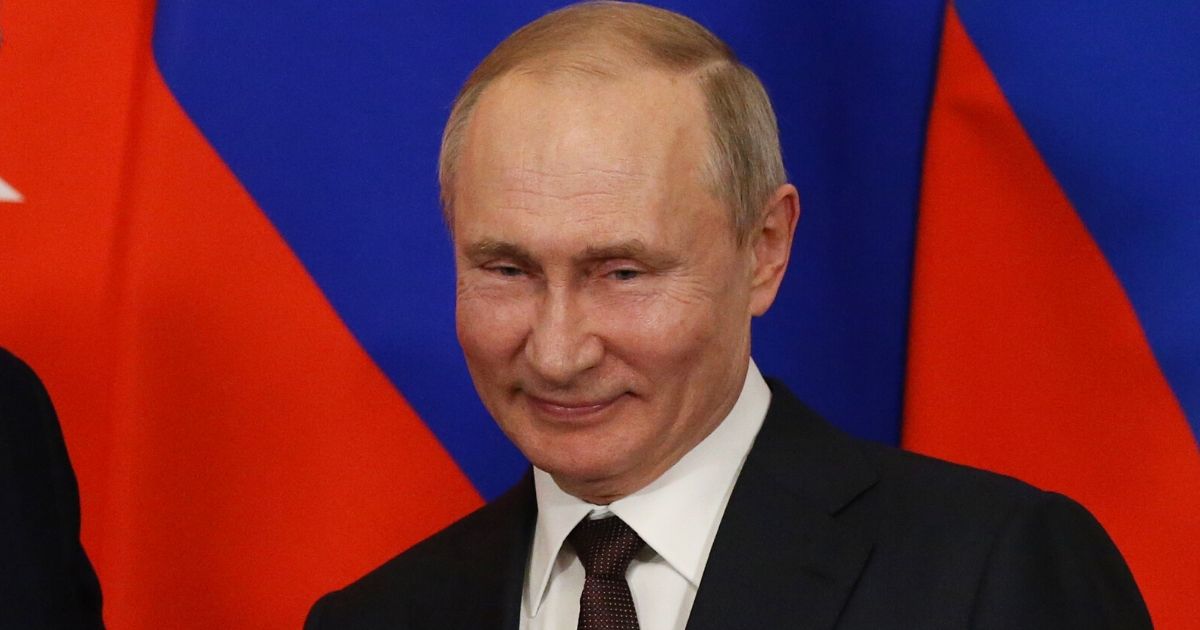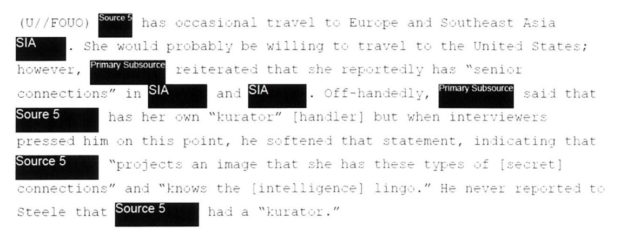
Declassified FBI Memo Shows Russia May Have Interfered - To Hurt Trump Campaign, Not Help It
An FBI memo declassified last week shows that the Steele dossier’s allegations about former Trump campaign aide Carter Page came from two sources, one of whom was described as having a Russian spy handler, while the other was the source of an allegation in the dossier that the FBI flagged as possible Russian disinformation.
The FBI document shows that a contractor for former British intelligence agent Christopher Steele told investigators in January 2017 that two women — identified as Source 3 and Source 5 — provided the information about Page that ended up in the dossier.
According to the 57-page FBI memo, the Steele contractor described Source 3 as “a close personal friend” who had provided information for him in the past about Russian companies and state entities. Steele’s source said that Source 5 had a “kurator” — or a handler — in Russian intelligence.
U.S. officials have increasingly eyed the possibility that the dossier’s many inaccuracies were the product of a Russian disinformation campaign.
Attorney General William Barr said in an interview in May that potential Russian disinformation is “one of the most troubling aspects” of the dossier saga, given that the FBI used it as part of its investigation of the Trump campaign.
Russian influence of the dossier would also prove ironic, given that Steele was hired by the Clinton campaign and Democratic National Committee to root out whether the Trump campaign and Kremlin were conspiring to influence the 2016 election.
Daniel Hoffman, a retired CIA station chief in Moscow, said that the Steele sub-source’s link to a Russian handler is a red flag of a possible disinformation effort.
“You’d need to know a little bit more about who this handler was,” Hoffman told The Daily Caller News Foundation, noting that the handler could have been with Russian intelligence or another entity.
“It sounds pretty nefarious, though.”
The document released on Friday summarizes interviews that Steele’s primary source had with the FBI and Justice Department lawyers over the course of three days in January 2017.
The source, who is unnamed, worked as a contractor for Steele’s firm, Orbis Business Intelligence.
According to the memo, the primary source collected information from six friends and associates in Russia regarding Russia’s election-related activities, Donald Trump and members of the Trump campaign.
Steele’s contractor said that Source 3 was one of the “key” sources for the dossier, according to the FBI memo.
The dossier’s allegations about Carter Page were central to the FBI’s investigation of the Trump campaign.
The FBI relied heavily on Steele’s information to obtain four Foreign Intelligence Surveillance Act orders to snoop on Page, who served as a foreign policy adviser on the campaign.
Steele’s dossier alleged that Page was a liaison between the Trump campaign and the Kremlin as part of a “well-developed conspiracy of cooperation” to influence the 2016 election.
Steele also asserted that Page met with two Kremlin insiders — Igor Sechin and Igor Diveykin — during a trip to Moscow in July 2016.
Page has vehemently denied ever meeting Sechin or Diveykin.
According to the FBI memo, Source 3 was behind the claim of the alleged Page-Diveykin meeting.
Source 3 said that Diveykin and Page discussed blackmail material that the Kremlin held on Trump.
Source 3 provided the information for another significant allegation believed to be Russian disinformation.
According to the FBI memo, Steele’s contractor said that Source 3 claimed that former Trump lawyer Michael Cohen visited Prague in August 2016 to meet with Kremlin insiders regarding election interference.
The Cohen-Prague claim was perhaps the dossier’s most specific allegation of collusion between a Trump associate and the Russian government.
But the allegation was false, according to reports from the special counsel’s office and the Justice Department’s inspector general.
Both offices said in 2019 reports that Cohen did not visit Prague. The IG report went further, saying that the FBI received evidence on Jan. 12, 2017, that the allegation about Cohen visiting Prague may have been the product of Russian disinformation.
Steele’s source said he did not ask Source 3 detailed questions about where she obtained her information about Page and Diveykin.
He said that the source was one of the few people who knew that he worked in the field of business intelligence, and that she knew he was “connected” in some way.
But he said he did not doubt her information and that he trusted her “100%.”
Steele’s source said he was also friends with Source 5, and that she had links to the Russian government and Russian intelligence.
According to the FBI memo, Steele’s contractor said that Source 5 had a Russian intelligence “kurator.”
The source told the FBI he did not tell Steele that Source 5 had a handler.
Steele, a former MI6 officer, has dismissed the idea that he fell victim to a Russian ruse, telling associates that he is well trained to spot disinformation.
Hoffman, the former CIA station chief, told the DCNF that the sub-source’s links to Russian intelligence operatives raise questions about the accuracy of their information.
“Did Steele know about this person? That’s a sure indication that your sub-source is blown and you don’t want to use them,” Hoffman said.
“Steele should have known better.”
Source 5 provided the allegation that Page met with Igor Sechin, the president of oil giant Rosneft and a Kremlin insider, during his trip to Moscow.
The source allegedly said that Sechin and Page discussed relaxing sanctions against Russia and Rosneft.

Passage from FBI memo of interviews with the primary source for the Steele dossier.
Steele’s source showed the FBI the text message he received from Source 5. It mentioned the issue of sanctions, but did not reference a brokerage stake in the Rosneft sale, as Steele claimed in the dossier.
There are several pieces of evidence that Russia’s intelligence service knew that Steele was investigating the Trump campaign in 2016.
The IG report said that the FBI received evidence in June 2017 that two Russian intelligence operatives knew in July 2016 that Steele was investigating Trump.
It also said that the FBI received information in late January 2017 that Russian intelligence may have targeted Steele’s firm, Orbis, and researched publicly available information about it.
The report also said that the FBI received evidence on Jan. 12, 2017, that the allegation about Cohen’s visit to Prague — which came from Source 3 — may have been Russian disinformation.
The dossier’s most salacious allegation — that the Kremlin had a blackmail sex video of Trump in Moscow — may also have been the product of disinformation.
On June 1, Barr that John Durham, the U.S. attorney for Connecticut, had begun investigating the possibility of Russian disinformation in the dossier as part of a sprawling probe of the intelligence-gathering activities against the Trump campaign.
Hoffman said the memo reinforces the disinformation theory.
“Russians would have spotted it, and then they had two options: they could disrupt it, or spin it back at us,” said Hoffman, who first floated the Russian disinformation theory in a January 2018 opinion piece for The Wall Street Journal.
The former spy noted that the FBI memo says that Steele and his primary source communicated by phone, email and Skype, which Hoffman said are “incredibly insecure.”
While the FBI memo sheds some light on Steele’s operation, the chief target of the dossier and FBI probe told the DCNF he is frustrated that so many details in the document remain hidden behind redactions.
“For whatever reason, they’ve now disclosed this almost indecipherable lump of Swiss cheese that’s full of countless unnecessary redactions,” Carter Page told the DCNF.
Content created by The Daily Caller News Foundation is available without charge to any eligible news publisher that can provide a large audience. For licensing opportunities of our original content, please contact licensing@dailycallernewsfoundation.org.
A version of this article appeared on The Daily Caller News Foundation website.
Truth and Accuracy
We are committed to truth and accuracy in all of our journalism. Read our editorial standards.
Advertise with The Western Journal and reach millions of highly engaged readers, while supporting our work. Advertise Today.











